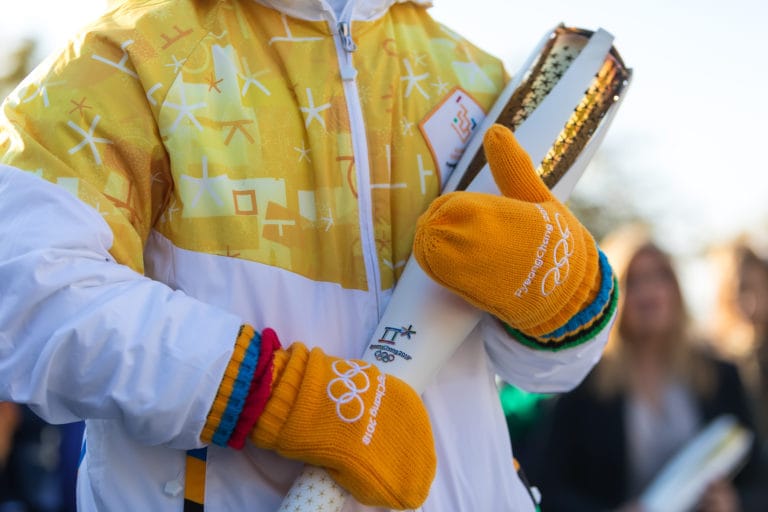Winning Mobile Gold at the Winter Olympics

February 7, 2018 | Article written by Carly Morris
The 2018 Winter Olympics start this week and digital brands around the world can anticipate some stellar viewership, both on and off television. With hundreds of millions of people tuning in each day from their laptops and mobile devices, getting the right message in the right place at the right time offers the potential for unprecedented international impact.
You know where your audience is, and you know why. Now all you have to do is land the right tricks, and you can take home the gold in mobile. With this in mind, here are the trends you need to know about the biggest sporting event of the year:
1. The Merit in Mobile
This year’s Winter Olympics will be more focused on mobile than ever before.
Whether it’s gearing up athletes with limited-edition devices to stay active, or offering a special 2018 Winter Olympics SIM card to keep everyone in Pyeongchang connected, the 2018 Games’ focus on smartphones is no secret.
Some of the biggest names in advertising have also begun to recognize the importance of mobile as a means to create a more comprehensive Olympic presence. At the Vancouver Winter Olympics back in 2010, Coca-Cola launched a first-of-its-kind partnership with NBC for a co-branded mobile app and bespoke mobile website.
According to Linda Cronin, Director of Media Interactive Communications at Coca-Cola North America, “More and more, people are customizing the way they receive news and information. They want it fast and they want it to fit within their on-the-go lifestyle. So, it’s only natural that our mobile channel is a critical element of our overall Olympic marketing strategy.”
The takeaway? Even the archetypal TV and experiential marketing goliaths are recognizing the merit in mobile when it comes to connected fans at the Olympics – especially in a place like South Korea, where mobile is king.
2. The SK Effect
The fact that this year’s Games are taking place in South Korea is a huge game-changer for mobile advertisers. South Korea is a traditionally mobile-focused market, where technological innovation and cutting-edge capabilities reign supreme. If you’re looking for an active mobile audience, South Korea is a bullseye.
In fact, this year smartphones will capture nearly 30% of total media time in South Korea. Topped only by China (by less than 1%), South Koreans are steadily leading the global shift towards a truly mobile-first experience.

3. Cord Cutters Pull Ahead
At the 2016 Summer Olympic Games in Rio de Janeiro, up to 33 million North Americans tuned in to watch on any given day. While this certainly represents an impressive captive audience, what’s even more interesting is the way that traditional viewing habits are evolving.
At the 2016 Summer Games, live streaming hit an unprecedented new high, with over 2.7 billion minutes of coverage consumed on NBC’s digital platforms.
This year, NBC will set another record, with the first-ever live streaming coverage of the Winter Games on their site and mobile app. This will hit a whopping 1,800 hours of non-television digital coverage, and a whole lot of opportunities for you to reach your audience while engaged with their mobile devices.
4. New Tech Brings the Games to Life
Many brands are also expanding their horizons in regards to new ways of presenting their content and remaining relevant to Olympics viewers on mobile. Shiny new tech like AR is taking engagement strategies to the next level, while others are turning to influencers and mobile-only offerings to create a mutual sense of unity and exclusivity – two of the core feelings that make the Olympics so exciting.
For example, Eurosport’s plan for fully-digital coverage will employ all of these strategies and more. The sports network will deliver live and on-demand multi-screen coverage of the Games in 48 European markets, allowing fans to customize their experience by choosing what, when, and how they’ll watch.
Eurosport will also offer AR and enhanced data to provide interactive analysis of all the action, and have secured a partnership with Snapchat to further expand their audience and explore new (and perhaps less competitive) streams for relevant audience engagement.
5. It’s All About the Experience
Feeling inspired? Here’s how you can take these trends home and perfect your own Olympic game plan:
Remember that for spectators, fans, and athletes, the Olympic Games are nothing if not a series of once-in-a-lifetime experiences. In the same way, it’s important that you do your part to extend a positive experience to your mobile audience too.
So, what makes for great UX around the Olympics? Data.
Take time to reflect on your audience’s typical behavioral patterns and key interests. If there’s a sport they can’t wait to watch, or a hometown hero getting all their love, you can leverage this information to engage them with personalized ads and push notifications that inspire and excite.
If you don’t have access to that kind of data, we can help. But if you’re looking for a quick fix to tide you over, it’s worth noting that almost any app or brand can be successful with winter and sports-themed creative in the coming weeks. That is, while the entire world has Winter Games on the brain.
Just like any time of the year, honing in on major cultural events is a great way to grab your audience’s interest with an ad that feels like it was made just for them.
Whatever route you choose to take, keep in mind that the Winter Games are meant to be fun and exciting. People are going to be extra active on mobile, but that doesn’t mean that you’ll have their undivided attention.
Be sure to avoid disruptive practices that will take your audience out of the moment, and focus instead on what will complement and enhance their overall experience.
Let the games begin!


